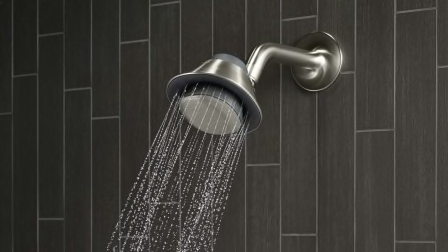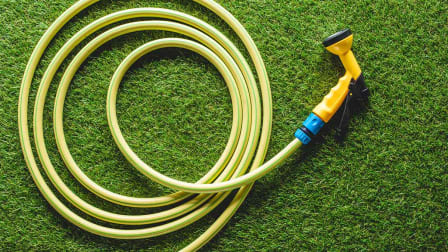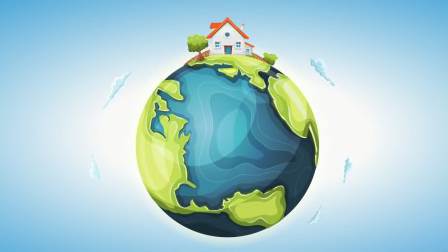How to Cut Your Water Use in Half
As drought conditions become the new norm, it's vital to save water. Here are some ways.

As of mid-August, more than 40 percent of the U.S. and almost 50 percent of the lower 48 states were in drought, according to drought.gov, an offshoot of the National Oceanic and Atmospheric Administration. Photographs of the Colorado River at low flow are stunning—and not in a good way.
In fact, the federal government recently announced a second round of water restrictions in the seven states that rely on water from the Colorado River Basin. Even in the East, states and communities have responded with limits on nonessential water use.
Unfortunately, such restrictions may be the new normal. That makes right now a prime time to assess your water consumption habits and challenge your water conservation IQ, even if you’re not among the 40 million Americans affected by the water shortage in the West.
There are lots of ways to conserve water floating around, but two of the best are to replace water-wasting appliances and fixtures, and to modify your lifestyle.
Save Water in the Bathroom
More water flows through your bathroom than any other room in the house. In fact, bathrooms account for more than half of all indoor water use.
But advances in plumbing technology mean that newer faucets, showers, and toilets use significantly less water than older models and still deliver the rinse, spray, and flush you expect.
If you’re looking to replace a bathroom fixture, look for one that carries the WaterSense label, indicating it meets EPA’s water-saving standards. Here are more water-saving steps you can take:
Replace your old toilets—all of them. Older toilets use as much as 6 gallons per flush; new WaterSense toilets do the job with 1.28 gallons or less. By replacing an older toilet with a newer one, the average family can reduce water use by 20 percent per toilet. (Toilets are just one of the products in our ratings that you can sort by water consumption, using the "filters" tab.)
Take shorter showers, limiting them to 5 minutes. (And take showers instead of baths.) If you’re brave, turn off the water when lathering up or shampooing. And shut off the water when brushing your teeth or shaving.
Replace your old showerhead. Standard showerheads use 2.5 gallons of water per minute. WaterSense showerheads use no more than 2 gpm. The difference really adds up.
Replace your old faucets. Replacing leaky or inefficient faucets and aerators with WaterSense models can save the average family 500 gallons of water per year.
Don’t use your toilet as a garbage can. It wastes water and can clog your pipes. Toilet paper is designed to disintegrate. Tissues, most wipes, and dental floss are not.
Save Water in the Kitchen
When it comes to wasting water in the kitchen, the dishwasher isn’t the culprit—it’s probably you.
Too many people rinse their dishes clean before putting them in a dishwasher designed to do that very job—and do it better than you can. Here are the water-saving steps you can take:
Don’t pre-rinse your dishes. An old kitchen faucet can use 1 to 3 gallons of water a minute when running full blast.
“The Energy Star dishwashers we test use 4 to 6 gallons per cycle,” says Larry Ciufo, who oversees Consumer Reports’ dishwasher tests. Water savings aside, your dishwasher will perform better loaded with dirty dishes, as CR explains in "Don’t Bother Prerinsing Your Dishes.")
Replace your old dishwasher. Energy Star dishwashers are about 15 percent more water-efficient than standard models, and are quieter, too. Consumer Reports’ Green Choice program identifies the most water- and energy-efficient dishwashers.
Wash only full loads of dishes. For maximum efficiency, load your dishwasher according to the instructions in your owner’s manual, which will make the most use of the sprays in your machine.
Refrigerate your drinking water instead of running the tap until it’s cool. If you like your water filtered, we have recommendations for the best water-filtering pitchers out there. Designate one glass or water bottle per person for the day so that it only needs to be washed once.
Give pots and pans a soak instead of scrubbing them under running water.
Install a WaterSense aerator on the kitchen faucet to reduce flow to less than 1 gallon per minute. It’s a cheap fix that costs only pennies. You can also avoid running the garbage disposal, and the water it requires, by composting your food scraps.
Save Water in the Laundry Room
The worst washing machines in our tests use more than twice as much as miserly Energy Star models, which use 10 to 12 gallons for an 8-pound load. Front-loaders are the most water efficient, followed by high-efficiency (HE) top-loaders and agitator top-loaders.
Like dishwashers, we also award our Green Choice leaf to the most water and energy-efficient washing machines. You’ll find the green leaf icon located next to the model name in our washing machine ratings.
Here are some more water conservation steps you can take:
Replace your old washer. Energy Star washing machines use about 40 percent less water than a regular washer. Bonus: Because high-efficiency models spin faster, the clothes need less drying time.
Pick the appropriate water level setting—often labeled small, medium, large—for the load if that’s how your machine works. Front-loaders and most HE top-loaders have auto-load sensing, and a few of the latest agitator top-loaders have it, too. That feature automatically determines the load size and the amount of water needed.
Measure laundry detergent and use HE detergents for HE machines. Regular detergents are too sudsy, and using too much can cause HE washers to use more water by extending the rinse cycle.
Do only full loads, but don’t overstuff. Using cold water whenever possible helps save on energy costs.
Pick the right soil setting for the load. Choosing the heavy-duty setting can use more water and extend wash time. The normal setting works for most loads.
Save Water Outdoors
That grassy lawn soaks up more water than any other plant in your yard, and homeowners tend to overwater their grass to keep it green. The fact is, an established lawn needs only 1 inch of water per week in the growing season, so pouring on the water can actually harm your turf, as well as the environment—and your budget.
Here are the water-saving steps you can take:
Let the grass grow longer by raising your lawn mower’s cutting height. Longer blades of grass help shade each other, reducing evaporation, so keep your grass between 3 and 4½ inches tall.
Stop fertilizing; it only promotes new growth. When you mow, leave grass clippings on the lawn to retain moisture and add nitrogen. If you use a sprinkler, direct the spray to the grass and garden and not the sidewalk and street.
Don’t use water to clean off your driveway, steps, or deck. Sweep them instead, or use a leaf blower. Wash your car with water from a bucket or go to a commercial car wash that recycles water.
When it rains, collect the water in barrels or install gutters and downspouts that direct the runoff to your plants and trees.
Reduce the size of your lawn. Consider replacing grass with mulch, ground cover, drought-tolerant plants, or ornamental grasses. Weeds compete with other plants for water, so weed regularly. And ditch any water features unless they use recycled water. To find the best plants for your region, consult your county cooperative extension or a local nursery.
Use soaker hoses or drip irrigation, if watering is permitted, to apply water slowly and evenly. Buy a hose nozzle with an automatic shutoff. Water early in the day when evaporation rates are low and more water is absorbed.




















